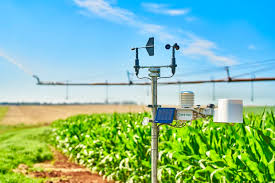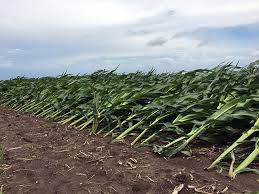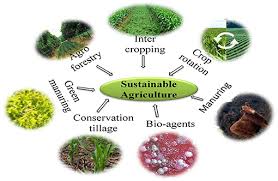The world population is steadily increasing each year, creating a demand for more food to adequately feed the growing population. The environment plays a primary role in influencing plant growth and development and has the greatest effect on crop distribution across the Earth.
Crop production is practiced over a wide range of agro-ecosystems, from very wet to very dry regions and from temperate to tropical and semi-arid zones.
The effects and interrelationships between climatic factors such as temperature, rainfall, solar radiation, and CO2 concentration determine the type of crops cultivated in various regions..In this article, the most important environmental factors that affect crop growth and development will be discussed.
Read Also: 7 Medicinal Health Benefits of Daffodils (Narcissus Plant)
Weather Elements and Their Influence on Crop Growth

Weather elements over the years determine the type of climate, which, in turn, influences the types of plants or crops cultivated. These elements of weather are fundamental to crop growth.
The rate of growth of roots, stems, and leaves depends on the rate of photosynthesis, which is influenced by light, temperature, moisture, and carbon dioxide concentration.
This article will explain the climatic factors that affect crop growth and production, and explore the most important environmental factors that impact crop growth and development. These factors include:
1. Light: The primary source of light is sunshine. The production of sugars by plants occurs only in the presence of sunlight. In regions with poor sunlight, photosynthetic activity and plant growth are limited.
Abundant sunshine, along with adequate rainfall and fertile soils, promotes the luxuriant growth of plants, as seen in tropical regions.
2. Water (Rainfall): All living organisms, including plants, require water for survival. Adequate rainfall or water availability is one of the most important environmental factors that limit growth and survival.
In addition to rainfall, rivers, lakes, and wells provide irrigation water to supplement rainfall. These sources also depend on rainfall for water supply.
Thus, rain is the only source of water for crops, either directly or indirectly. Rainfall received at the right time and in the desired quantity is an invaluable gift from nature. Insufficient rainfall limits plant growth, while excessive rainfall can also be detrimental.
Heavy rainfall can cause erosion, leaching, and sometimes create waterlogged conditions in fields. Waterlogged soils do not permit aeration, leading to poor growth and development of plants.
3. Temperature: Temperature influences various physiological activities in plants, including photosynthesis, respiration, evapotranspiration, and the activities of soil microorganisms.
There is an optimum range of temperature that is most favorable for these processes. Any deviation from this range can negatively affect plant growth and development. Temperature conditions in Nigeria are mostly favorable for plant growth and development.
4. Humidity: Humidity is closely linked to rainfall. High humidity in the atmosphere reduces transpiration in plants and the evaporation of soil moisture.
Low humidity, on the other hand, increases the water requirements of plants, thereby raising the cost of crop production through irrigation. High humidity can also reduce plant resistance to fungal diseases in some cases and encourage pest outbreaks in certain locations.
Read Also: Bacterial Canker (Stone fruit trees): Description, Damages Caused, Control and Preventive Measures
5. Wind: Wind aids in the pollination of crops and helps reduce atmospheric temperature. However, it can have harmful effects as well. Excessive wind leads to water loss from soils through evaporation and transpiration, increasing the need for irrigation.

Strong winds can also interfere with fruit setting and promote fruit fall, especially in orchards. Mature cereal crops may be lodged during strong winds, leading to losses and higher harvesting costs. In semi-arid zones, wind can also result in the loss of topsoil.
6. Soil Salinity and Sodicity: Soluble salts are formed by the weathering of rocks. In arid regions, when these salts are not completely leached, they move down to lower soil layers with percolating rainwater and rise to the surface with capillary moisture movement.
This cycle of up and down movement of soluble salts leads to varying concentrations at different soil layers, creating salinity. In sodicity, soluble salts that are not leached out of the soil remain concentrated in the surface layers.
When sodium becomes the dominant base in the clay complex, sodicity conditions develop. Upon saturation, the sodium ions in the clay form sodium hydroxide, creating an alkaline reaction in the soil solution.
The sodium hydroxide reacts with carbon dioxide from the soil air, forming sodium carbonate and raising the soil’s pH to as high as 10. These conditions are not conducive for plant growth. Growing crops under such conditions requires extensive soil conditioning and amelioration.
From this study, several environmental resources that influence plant growth and development in particular regions have been identified. These include weather elements and extreme edaphic factors.
Climatic factors should be seen as interrelated for the benefit of crops. Alarming variations in weather elements are particularly critical when studying climate change, which has become one of the most pressing environmental issues facing humanity today.
Do you have any questions, suggestions, or contributions? If so, please feel free to use the comment box below to share your thoughts. We also encourage you to kindly share this information with others who might benefit from it. Since we can’t reach everyone at once, we truly appreciate your help in spreading the word. Thank you so much for your support and for sharing!

